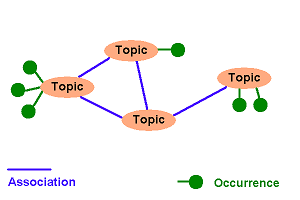For programmers, many software libraries, called Topic Maps engines are available to use, some of which are part of complete knowledge management solutions.
Students and academics will find the Topic Maps Library useful. It includes many publications, a glossary, information about standards and more.
Many companies offer commercial services and/or consulting around Topic Maps products. The list of sponsors of TMRA is a good place to look for them. The Topic Maps Projects list gives some starting points, too.
The Standards are available through ISO. The latest versions can also be obtained at isotopicmaps.org. The most prominent standard is the Topic Maps Data Model which uses XTM 2 and CTM as serializations.
The purpose of a topic map is to convey knowledge about resources through a superimposed layer, or map, of the resources. A topic map captures the subjects of which resources speak, and the relationships between subjects, in a way that is implementation-independent.
A topic is a resource that acts as a proxy for some subject; it is the topic map system's representation of that subject.
The key concepts in topic maps are topics, associations, and occurrences.
An association is a relationship between one or more topics, each of which plays a role as a member of that association. The roles a topic plays in associations are among the characteristics that can be assigned to it and are therefore governed by scope. Each individual association is an instance of a single class of association (also known as an association type) that may or may not be indicated explicitly.
Topics can have names. They can also have occurrences, that is, information resources that are considered to be relevant in some way to their subject.
Topics can participate in relationships, called associations, in which they play roles as members.

No comments:
Post a Comment